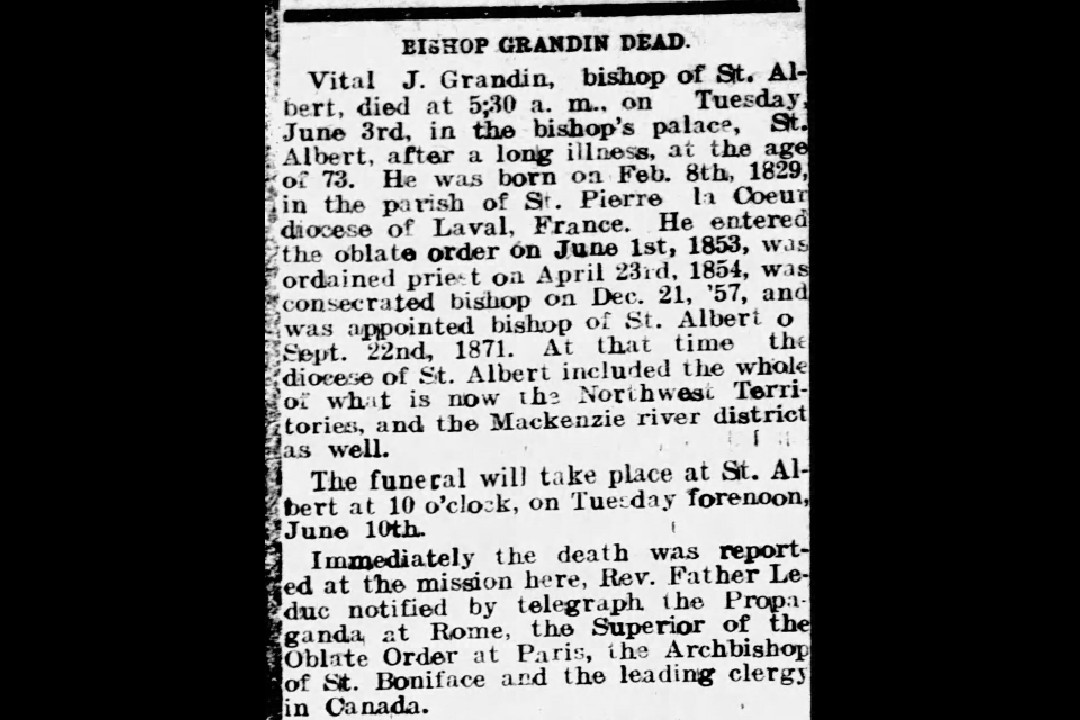On this day in 1902, people were learning of the death of a man who had immeasurably changed both Edmonton and Alberta, but who had also been a central architect of the residential school system in Canada.
Vital Justin Grandin was born in France in 1829. After being ordained a Roman Catholic priest, Grandin arrived in Canada, first landing in what would become Manitoba in 1854. Grandin would spend the next 15 years working in missions in what would become Manitoba and Saskatchewan, before moving to the Catholic mission in St. Albert. Soon after, he was named the bishop of the new archdiocese in the growing community.
At the time, St. Albert was the Catholic Church's anchor in Western Canada, and Grandin had a significant influence on the growth of the mission, as well as on neighbouring Edmonton. Grandin cooperated with the Grey Nuns to establish healthcare, social welfare, and educational facilities in St. Albert, and later was involved in the founding of the first hospital in Edmonton. Grandin also used his position to encourage Francophone settlement in Alberta.
For a century after his death in 1902, Grandin's name appeared on things across Alberta — including one of St. Albert's oldest neighbourhoods, an LRT station near Edmonton's General Hospital, and Catholic schools in both Edmonton and Calgary. But recent years have seen attention shift to Grandin's role in creating and advocating for Canada's residential school system, and the resulting devastation it had on Indigenous people, cultures, and communities.
Grandin expressed his belief that Indigenous people should be welcomed as Catholic clergy, a rare opinion at the time. However, Grandin's attitudes were still based on colonial, racist, and assimilationist beliefs. For example, he argued that Indigenous children needed to be separated from their cultures and forced to adopt European norms and values.
He appealed directly to Prime Minister John A. Macdonald for a residential school system that would separate Indigenous children from their parents and communities. His belief was partially inspired by a prison he had visited in France. Grandin was convinced parents would willingly surrender their children to this school system (which was very much not the case). He would later write that he hoped to create within Indigenous people, a "pronounced distaste for the native life so that they will be humiliated when reminded of their origin."
Grandin spent years championing residential schools, meeting with and writing letters to politicians and other leaders, and he was instrumental in creating the system. That system saw 130 schools across Canada, 25 of them in Alberta (the most of any province), separate at least 150,000 children from their communities. The system's last school closed only in 1996. The cumulative effect is a wound from neglect, violence, sexual abuse, death, and cultural genocide that continues to dampen so many Indigenous lives to this day.
Following the Truth and Reconciliation Commission of Canada's report on residential schools, published in 2015, many began to push to remove Grandin's name from local institutions. In 2021, Edmonton renamed Grandin LRT station and removed a mural honouring the bishop. That same year, three Catholic schools named after Grandin — one each in Edmonton, St. Albert, and Calgary — also changed their names.
This spring, St. Albert announced it will remove Grandin's name from one of its oldest neighbourhoods, as well as several streets, following months of consideration and debate. The neighbourhood will now be dubbed The Gardens.
This clipping was found on Vintage Edmonton, a daily look at Edmonton's history from armchair archivist Rev Recluse of Vintage Edmonton.

